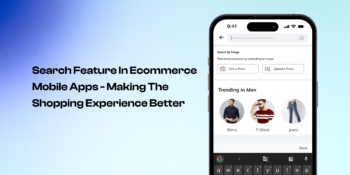
Mobile commerce, or “m-commerce,” has become an integral part of the retail industry. With the rise of mobile devices and the convenience of shopping on-the-go, the mobile commerce market has experienced exponential growth in recent years. According to Statista, the global mobile commerce market is projected to reach US $4.11 trillion in 2023 and is expected to reach a projected market volume of US $6.35 trillion by 2027 and continue growing in the years to come.
As we look ahead to 2023, it’s clear that mobile commerce will continue to shape the retail industry in significant ways. In this article, we’ll explore the top trends in mobile commerce for 2023 and the role that no-code app makers are playing in driving innovation and democratizing the industry.
Trend #1: Continued Growth in Mobile Payments
One of the biggest trends in mobile commerce is the continued growth of mobile payments. With the rise of contactless payment technologies and mobile wallets, consumers are increasingly using their mobile devices to make purchases. According to a survey by eMarketer, mobile payments in the US are projected to reach $314 billion in 2023, up from $137 billion in 2019.
The convenience and security of mobile payments make them an attractive option for both consumers and businesses. Mobile payments allow customers to make purchases quickly and easily without the need for physical credit cards or cash. For businesses, mobile payments offer faster and more secure payment processing, reducing the risk of fraud and chargebacks.
No-code app makers are playing a key role in enabling businesses to integrate mobile payment technologies into their mobile commerce apps. By using no-code app makers, businesses can easily add payment gateways, such as PayPal or Stripe, to their apps without the need for coding skills.
Trend #2: Personalization and AI-Powered Recommendations
Another important trend in mobile commerce is the increasing importance of personalization and AI-powered recommendations. With the growing competition in the mobile commerce space, businesses need to offer personalized experiences that engage and retain customers.
Personalization involves tailoring the shopping experience to the individual customer’s preferences and needs. This can include personalized product recommendations, customized promotions, and targeted marketing campaigns. By offering personalized experiences, businesses can increase customer loyalty and drive sales.
AI-powered recommendations are a key tool for delivering personalized experiences in mobile commerce apps. By analyzing customer data, such as browsing history and purchase behavior, AI algorithms can suggest products that are likely to interest the customer. This not only improves the shopping experience for the customer but also increases the likelihood of a purchase.
No-code app makers are making it easier for businesses to integrate personalization and AI-powered recommendations into their mobile commerce apps. By using pre-built AI-powered modules and drag-and-drop interfaces, businesses can create customized shopping experiences without the need for coding skills.
Trend #3: Augmented and Virtual Reality
Augmented and virtual reality technologies have been around for some time, but they are becoming increasingly important in the mobile commerce space. These technologies allow customers to visualize products in new and exciting ways, enhancing the shopping experience and increasing the likelihood of a purchase.
Augmented reality overlays digital information onto the real world, allowing customers to see how products will look in their environment. For example, a furniture retailer could use augmented reality to show customers how a particular sofa would look in their living room.
Virtual reality, on the other hand, creates a fully immersive experience, allowing customers to explore products in a virtual environment. This can be particularly useful for products that are difficult to showcase in a physical store, such as travel destinations or high-end technology.
No-code app makers are enabling businesses to create augmented and virtual reality experiences in their mobile commerce apps without the need for coding skills. By using pre-built modules and drag-and-drop interfaces, businesses can easily add these technologies to their mobile commerce apps, enhancing the shopping experience for their customers and driving sales.
Trend #4: Increased Focus on Social Commerce
Social commerce, The integration of social media and e-commerce has been on the rise in recent years. With the popularity of social media platforms such as Instagram and Facebook, businesses are looking for new ways to reach customers and sell their products.
In 2023, we can expect to see an increased focus on social commerce in the mobile commerce space. Social commerce allows businesses to sell products directly through social media platforms such as Instagram Shopping, Youtube Shopping, or Facebook Marketplace. This not only provides a new sales channel for businesses but also offers a seamless shopping experience for customers.
No-code app makers are enabling businesses to integrate social commerce into their mobile commerce apps, making it easier for customers to discover and purchase products through social media channels. By using pre-built integrations and drag-and-drop interfaces, businesses can create a seamless shopping experience that integrates with social media platforms.
Trend #5: Greater Emphasis on Sustainability
Sustainability has become a key issue in the retail industry, and this is true for mobile commerce as well. Consumers are increasingly concerned about the environmental impact of their purchases and are looking for businesses that prioritize sustainability.
In 2023, we can expect to see a greater emphasis on sustainability in the mobile commerce space. This may include initiatives such as reducing packaging waste, using eco-friendly materials, and partnering with environmentally conscious suppliers.
No-code app makers are enabling businesses to showcase their sustainability efforts in their mobile commerce apps. By using pre-built modules and templates, businesses can easily create pages and features that highlight their sustainability initiatives and communicate their commitment to environmental responsibility.
The Role of No-Code App Makers in Mobile Commerce
No-code app makers are playing a significant role in driving innovation and democratizing the mobile commerce industry. By providing pre-built modules, templates, and drag-and-drop interfaces, no-code app makers are enabling businesses to create mobile commerce apps without the need for coding skills.
This not only reduces the cost and complexity of app development but also allows businesses to iterate and innovate more quickly. No-code app makers are also making it possible for businesses of all sizes to participate in the mobile commerce space, democratizing access to this important sales channel.
So, what are the top trends in mobile commerce for 2023?
Firstly, we can expect to see a continued growth in the use of mobile wallets and contactless payments as consumers demand faster and more secure payment methods. In addition, personalization and AI-powered recommendations will become increasingly important, allowing businesses to offer tailored product suggestions and improve the overall customer experience. Furthermore, the use of voice-activated search and purchasing is set to rise, making it easier for customers to shop on the go.
In conclusion, mobile commerce is set to continue its growth in 2023, and no-code app makers will play a key role in driving innovation and democratizing the industry. By focusing on trends such as mobile payments, personalization, augmented and virtual reality, social commerce, and sustainability, businesses can create mobile commerce apps that provide seamless and engaging shopping experiences for their customers.










No Comments
Leave a comment Cancel